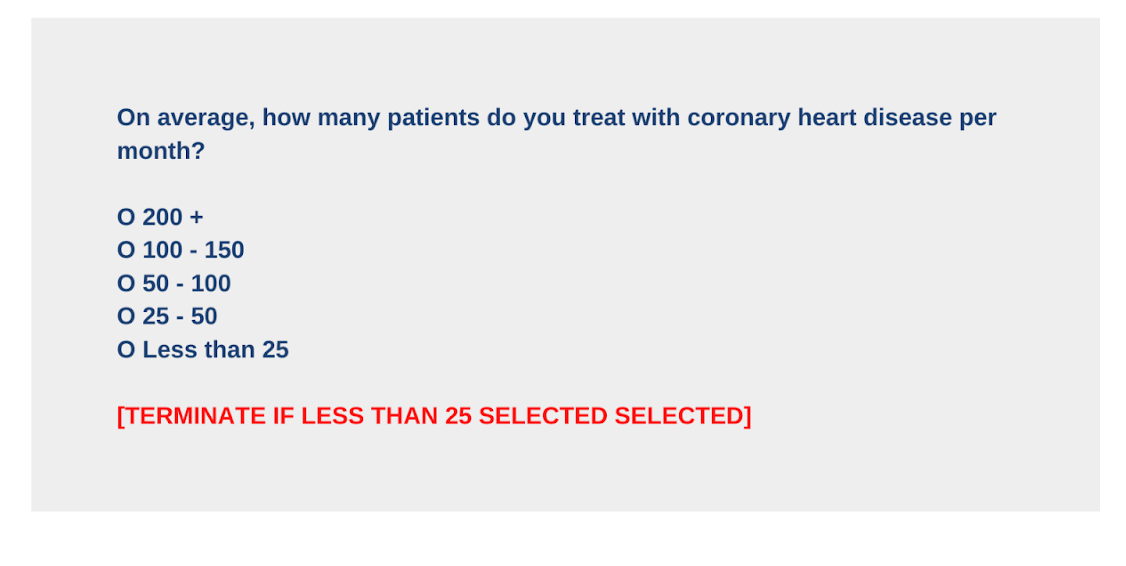In today's fast-paced world, the need for expert networks in healthcare and life sciences has never...
Screening questions are critical for any research study. They help identify eligible participants who meet study criteria and exclude those who do not to ensure relevancy so the results are accurate and meaningful. Ultimately, the quality of your research findings will depend on your screening questions. Therefore, it is essential to craft solid questions that are clear, concise and avoid leading the participant's response to provide you with the most accurate and reliable data.
In this article, we will explore the importance of crafting effective screening questions for your research and offer tips to help you create questions that will improve the quality of your data.
.png?width=798&height=479&name=Untitled%20design%20(14).png)
How to Create Effective Screening Questions
At Techspert, we know that crafting practical screening questions can be a challenging task. To ensure you gain the precise insights you need, our team of project managers offers end-to-end support on all projects. For now, here are some extra tips that will help you create questions that will improve the quality of your data and ensure that you are getting the right participants for your study.
1. Define your Study Objectives
The first step in creating practical screening questions is to define your study objectives by understanding the purpose of your study. What are you trying to achieve with your research, and what information do you need from your participants?
Being clear on this will help you identify the criteria that participants must meet to be eligible for your research and enable you to create screening questions tailored to your specific needs.
For example, suppose you are conducting a study on the potential uptake of a new medication for a particular medical condition. In that case, your screening questions must be designed to identify participants who have experience treating said medical condition and are not biased toward prescribing older treatments over any new medications, as this may interfere with the study's results.
2. Keep it Simple
When creating screening questions, it is imperative to keep them simple and easy to understand. Try to use either a yes/no response, multiple choice, or a quantitative figure. When asking for figures, specify the context – are you looking for the exact number of patients an expert treats per month or a percentage that presents with the condition you’re researching?
With that in mind, you should always consider the target audience. The language used in the survey should be familiar to the audience to ensure that they can understand the questions and provide accurate answers. So, avoid using technical jargon or complicated language that might confuse participants. Instead, use clear and concise language that is easy to understand. For example, instead of asking, ‘Have you ever been diagnosed with hyperlipidemia?’ you might ask, ‘Have you ever been told that you have high cholesterol?’ This makes the question easier to understand and increases the likelihood that participants will answer it accurately.
Generally, you should avoid using free-text fields for responses unless it’s necessary for the type of research you’re doing, as text responses can be highly subjective and will vary widely. Try to keep the flow of questions clear and logical so it’s as easy for experts to fill it out.

An example of a question that is open to many variable responses.

An example of an easy-to-answer question in a more user-friendly format.
The response options you provide can significantly impact the accuracy of your survey data and, thus, your end results. Use response options that are appropriate for the questions you are asking. For example, if you ask about age, use age ranges relevant to your target audience. Also, make sure that the response options are exhaustive and mutually exclusive. Respondents should be able to choose only one response that best fits their answer.
Additionally, it is essential to consider the number of response options. Too few options may not provide enough information, while too many can be overwhelming and confusing for respondents. A good rule of thumb is to deliver between 3 to 7 response options for each question.
3. Be Specific
Specificity is crucial when creating screening questions. Make sure that your questions are specific enough to identify the characteristics you want in your participants. For example, if you are conducting a study on the effects of a new medication on patients with type 2 diabetes, you might include screening questions about the participant's blood sugar levels and their current diabetes medication regimen.
To ensure clarity, it is also essential to avoid using double-barreled questions. These questions ask two questions simultaneously, leading to confusion and inaccurate responses. For example, ‘Do you like the product and the packaging?’ is a double-barreled question because it asks about two different aspects of the product.
4. Avoid Biased Questions
When creating screening questions, it is consequential to avoid biased questions as they can lead to inaccurate results and affect your data's quality. Leading questions are a specific type of biased questions suggesting a specific answer or point of view. These questions can negatively impact the credibility of survey results. These questions can be created intentionally or unintentionally. Ensure your questions are neutral and do not suggest a specific answer.
For example, a question such as ‘Do you agree that our product is the best on the market?’ suggests that the product is the best, or ‘Do you believe that alternative medicine is effective?’ leads the respondent to answer positively.
Instead, ask neutral and objective questions that do not imply a particular answer. For example, rather than asking, ‘Do you agree that our product is the best on the market?’ try asking, ‘How would you rate our product?’. For the question, ‘Do you agree that our product is the best on the market?’ you could consider ‘How do you think our product compares to other products on the market?’ as an alternative, as this question is neutral and does not suggest a specific answer.
5. Pilot Test your Questions
Before using your screening questions in your study, it is vital to test them, as this will allow you to see how your questions perform in a real-world setting. Pilot testing can be conducted online, by phone, or in person, depending on the survey method. Still, selecting a representative sample of the target audience is essential to ensure the survey is effective.
Testing questions with a small group of respondents can help you to identify any issues or problems with your questions or response options and can help you to refine them to make the screener more effective. This will also highlight any questions that may be confusing or difficult to answer, allowing you to make changes before administering the survey to a larger audience.
6. Consider the Time and Effort Required to Respond
When crafting screening questions, consider the time and effort required to answer them. Participants are more likely to answer your questions accurately if they are not too time-consuming or difficult to answer. Conversely, long and complicated questions can be challenging to answer and may cause respondents to skip questions or provide inaccurate answers. To avoid making your questions too burdensome, consider the length of your questionnaire and the number of questions you ask. If you request many answers, consider breaking them into multiple sections or pages to make them more manageable.
Ensure your screener is as concise as possible while capturing all the necessary information to gain the right insights for your project. Don’t include unnecessary information or context, and don’t make questions too long – you should aim to have the absolute minimum number of questions necessary to capture the right people.
Remember that experts aren’t getting paid to fill out screeners. If you need more information or an additional screening stage before kicking off your project, speak to your project manager about setting up a paid questionnaire once they’ve passed the screener.
7. Include Qualifying and Disqualifying Questions
Qualifying questions will identify participants who meet the criteria for your study while disqualifying questions can identify participants who do not meet the requirements. Including both types of questions can help you to identify the right participants for your research and ensure that your results are accurate and meaningful.
A good screener will usually follow a linear set of questions designed to filter out the exact type of expert you need – which means setting clear termination criteria for each question. For example, if you’re looking for key opinion leaders (KOLs) with ten years of experience, ensure you add a clear termination trigger for responses under ten years.
An example of a set of questions that have clear termination criteria.
8. Consider the Order of Your Questions
The order of screening questions can significantly impact the quality of data collected. The way questions are presented often influences how respondents answer, which can affect the accuracy and reliability of the data.
For example, if a sensitive question is asked at the beginning of a survey, respondents may feel uncomfortable and less likely to answer honestly. On the other hand, if a sensitive question is added at the end of a survey, respondents may feel more comfortable answering truthfully since they have a better understanding of the context behind your project. Generally, it is best to start with more general questions and gradually move to more specific questions. Employing this method helps participants ease into the process and feel more comfortable answering the later questions.
Similarly, the order of questions can influence how respondents interpret and answer subsequent questions. For instance, if a question about business spending habits follows a question about budgets, respondents may be more likely to under-report their budgets to justify their spending.
Additionally, it is best to ask demographic questions at the end of the screening questions, as this can help reduce potential biases.
Overall, the order of screening questions should be carefully considered to minimize bias and maximize the accuracy and reliability of the data collected.
Conclusion
Crafting effective screening questions is essential for any research study. It helps to identify the right participants for your study and ensures that your results are accurate and meaningful. By following these tips, you can create screening questions tailored to your specific needs, easy to understand, and free from bias. Remember to test your questions before using them in your study, and consider the time and effort required to answer them. With careful consideration and planning, you can create screening questions that will improve your data's quality and help you achieve your research objectives.






